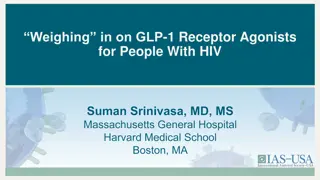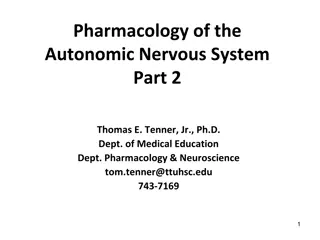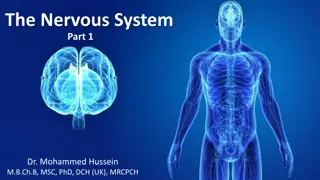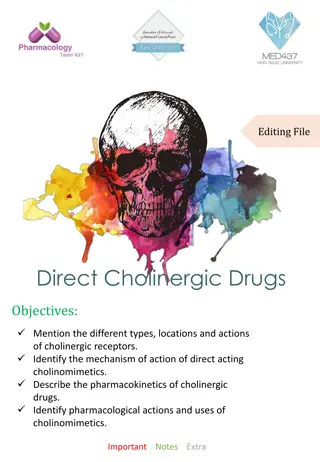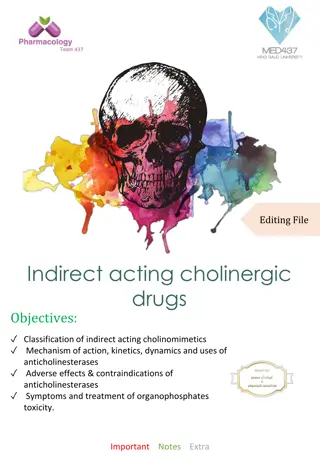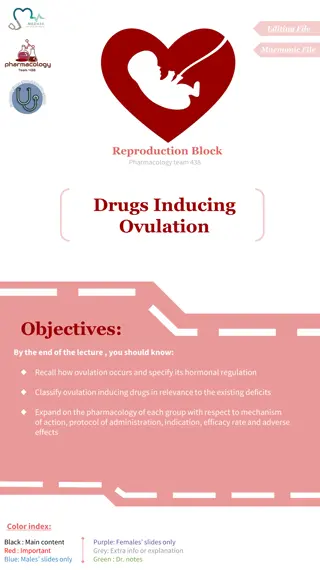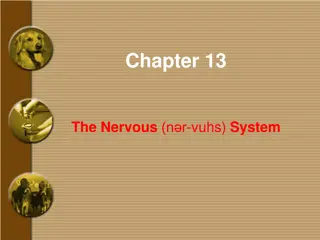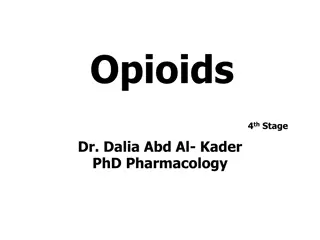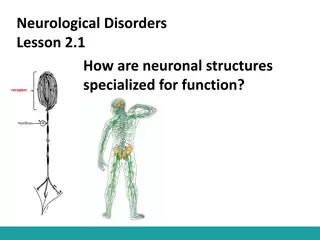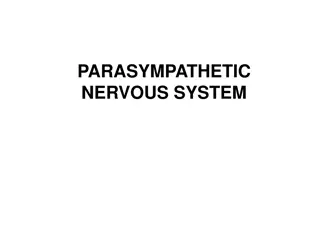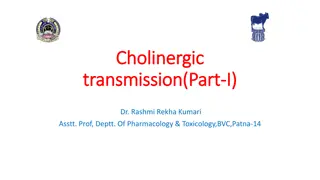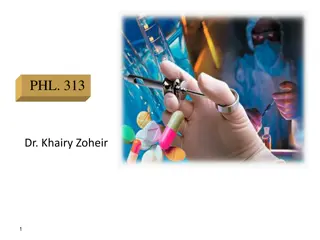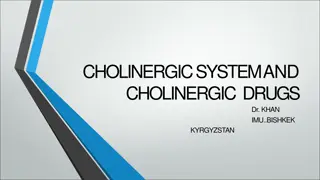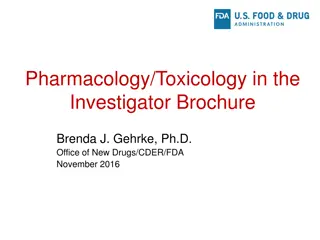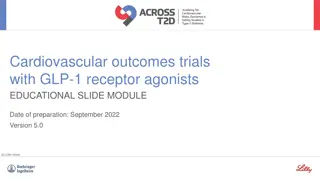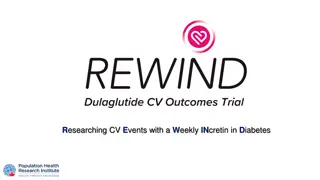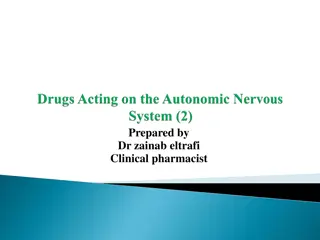Understanding Cholinergic Neurons and Agonists in Pharmacology
Cholinergic neurons play a vital role in neurotransmission by utilizing acetylcholine (ACh) as a neurotransmitter. This neurotransmission involves steps like synthesis, storage in vesicles, release, receptor binding, degradation, and recycling of choline and acetate. Choline acetyltransferase catalyzes the synthesis of ACh. The process is tightly regulated and involves various components like presynaptic vesicles, calcium influx, and specific inhibitors/blockers. Cholinergic agonists are substances that activate cholinergic receptors, affecting various systems like the autonomic nervous system and the somatic system. Understanding these mechanisms is crucial in the field of pharmacology.
Download Presentation

Please find below an Image/Link to download the presentation.
The content on the website is provided AS IS for your information and personal use only. It may not be sold, licensed, or shared on other websites without obtaining consent from the author. Download presentation by click this link. If you encounter any issues during the download, it is possible that the publisher has removed the file from their server.
E N D
Presentation Transcript
Cholinergic Agonists 1 Dr. Dalia Abd Al- Kader PhD Pharmacology
THE CHOLINERGIC NEURON 1. The preganglionic fibers terminating in the adrenal medulla 2. The autonomic ganglia (both parasympathetic and sympathetic) 3. The postganglionic fibers of the parasympathetic division use ACh as a neurotransmitter 4. The postganglionic sympathetic division of sweat glands also uses acetylcholine. 5. cholinergic neurons innervate the muscles of the somatic system and also play an important role in the central nervous system (CNS).
Neurotransmission at cholinergic neurons Involves six sequential steps: 1) Synthesis 2) storage 3) release 4) binding of ACh to a receptor 5) degradation of the neurotransmitter in the synaptic cleft (that is, the space between the nerve endings and adjacent receptors located on nerves or effector organs) 6) recycling of choline and acetate .
1. Synthesis of acetylcholine: Choline is transported from the extracellular fluid into the cytoplasm of the cholinergic neuron by an energy-dependent carrier system that cotransport sodium and can be inhibited by the drug hemicholinium. [Note: Choline has a quaternary nitrogen and carries a permanent positive charge and, thus, cannot diffuse through the membrane.] The uptake of choline is the rate-limiting step in ACh synthesis. Choline acetyltransferase catalyzes the reaction of choline with acetyl coenzyme A (CoA) to form ACh (an ester) in the cytosol.
2. Storage of acetylcholine in vesicles: ACh is packaged and stored into presynaptic vesicles by an active transport process. The mature vesicle contains not only ACh but also adenosine triphosphate and proteoglycan. Most synaptic vesicles contain the primary neurotransmitter (here, ACh) as well as a cotransmitter that increases or decreases the effect of the primary neurotransmitter.
3. Release of acetylcholine: When an action potential propagated by voltage- sensitive sodium channels arrives at a nerve ending, voltage-sensitive calcium presynaptic membrane open, causing an increase in the conc. of intracellular calcium. Elevated calcium levels promote the fusion of synaptic vesicles with the cell membrane and the release of their contents into the synaptic space. This release can be blocked by botulinum toxin. In contrast, the toxin in black widow spider venom causes all the ACh stored in synaptic vesicles to empty into the synaptic gap. channels on the
4. Binding to the receptor: ACh released from the synaptic vesicles diffuses across the synaptic space and binds to postsynaptic receptors on the target cell, to presynaptic receptors on the membrane of the neuron that released the ACh, or to other targeted presynaptic receptors. The postsynaptic cholinergic receptors on the surface of the effector organs are divided into two classes, muscarinic and nicotinic. Binding to a receptor leads to a biologic response within the cell, such as the initiation of a nerve impulse in a postganglionic fiber or activation of specific enzymes in effector cells, as mediated by second messenger molecules.
5. Degradation of acetylcholine: The signal at the postjunctional effector site is rapidly terminated, because acetylcholinesterase (AChE) cleaves ACh to choline and acetate in the synaptic cleft. [Note: Butyrylcholinesterase, sometimes called pseudocholinesterase, is found in the plasma, but does not play a significant role in the termination of the effect of ACh in the synapse.
CHOLINERGIC RECEPTORS (CHOLINOCEPTORS) Two families of cholinoceptors, muscarinic and nicotinic receptors, can be distinguished from each other on the basis of their different affinities for agents that mimic the action of Ach (cholinomimetic agents).
A. Muscarinic receptors Muscarinic receptors belong to the class of G protein coupled receptors (metabotropic receptors). These receptors, in addition to binding ACh, also recognize muscarine, an alkaloid that is present in certain poisonous mushrooms. In contrast, the muscarinic receptors show only a weak affinity for nicotine. There are five subclasses of muscarinic receptors. However, only M1, M2, and M3 receptors have been functionally characterized.
Locations of muscarinic receptors: These receptors are found on: ganglia of the peripheral nervous system on the autonomic effector organs, such as the heart, smooth muscle, brain, and exocrine glands. Although all five subtypes are found on neurons, M1 receptors are also found on gastric parietal cells, M2 receptors on cardiac cells and smooth muscle, M3 receptors on the bladder, exocrine glands, and smooth muscle. [Note: Drugs with muscarinic actions stimulate muscarinic receptors on these tissues, but at high conc., they may show some activity at nicotinic receptors.]
Mechanisms of acetylcholine signal transduction when M1 or M3 receptors are activated, the receptor undergoes a conformational change and interacts with a G protein(Gq) that in turn activates phospholipase C. This ultimately leads to the production of the second messengers inositol-1,4,5- trisphosphate (IP3) and diacylglycerol (DAG). IP3 causes an increase in intracellular Ca2+. Calcium can then interact to stimulate or inhibit enzymes or to cause hyperpolarization, secretion, or contraction. Diacylglycerol activates protein kinase C, an enzyme that phosphorylates numerous proteins within the cell.
In contrast, activation of the M2 subtype on the cardiac muscle stimulates a G protein, (Gi), that inhibits adenylyl cyclase and increases K+ conductance. The heart responds with a decrease in rate and force of contraction.
Muscarinic agonists: Pilocarpine is an example of a nonselective muscarinic agonist used in clinical practice to treat xerostomia and glaucoma. M1 receptor agonists are being investigated for the treatment of Alzheimer s disease and M3 receptor antagonists for the treatment of chronic obstructive pulmonary disease.
B. Nicotinic receptors These receptors, in addition to binding ACh, also recognize nicotine but show only a weak affinity for muscarine . The nicotinic receptor is composed of five subunits, and it functions as a ligand-gated ion channel. Binding of two ACh molecules elicits a conformational change that allows the entry of sodium ions, resulting in the depolarization of the effector cell. Nicotine at low concentration stimulates the receptor, whereas nicotine at high concentration blocks the receptor.
Nicotinic receptors are located in the CNS, the adrenal medulla, autonomic ganglia, and the neuromuscular junction (NMJ) in skeletal muscles. Those at the NMJ are sometimes designated NM, and the others, NN. The nicotinic receptors of autonomic ganglia differ from those of the NMJ. For example, ganglionic receptors are selectively blocked by mecamylamine, whereas NMJ receptors are specifically blocked by atracurium.
DIRECT-ACTING CHOLINERGIC AGONISTS Cholinergic agonists mimic the effects of ACh by binding directly to Cholinoceptors (muscarinic or nicotinic). These agents classified into two groups: 1) endogenous choline esters, which include Ach and synthetic esters of choline, such as carbachol and bethanechol,
2) naturally occurring alkaloids, such as nicotine and pilocarpine. All of the direct- acting cholinergic drugs have a longer duration of action than ACh. The more therapeutically useful drugs (pilocarpine and bethanechol) bind to muscarinic receptors and are sometimes referred to as muscarinic agents. However, as a group, the direct-acting agonists show little specificity in their actions, which limits their clinical usefulness.
A. Acetylcholine is a quaternary ammonium compound that cannot penetrate membranes. Although it is the neurotransmitter of parasympathetic and somatic nerves as well as autonomic ganglia, it lacks therapeutic importance becauseof its multiplicity of actions (leading to diffuse effects) and its rapid inactivation by the cholinesterases. ACh has both muscarinic and nicotinic activity. Its actions include the following:
1. Decrease in heart rate and cardiac output: The actions of Ach on the heart mimic the effects of vagal stimulation.
2. Decrease in blood pressure: Injection of ACh causes vasodilation and lowering of blood pressure by an indirect mechanism of action. ACh activates M3 receptors found on endothelial cells lining the smooth muscles of blood vessels. This results in the production of nitric oxide from arginine. Nitric oxide then diffuses to vascular smooth muscle cells to stimulate protein kinase G production, leading to hyperpolarization and smooth muscle relaxation via phosphodiesterase-3 inhibition. In the absence of administered cholinergic agents, the vascular cholinergic receptors have no known function, because ACh is never released into the blood in significant quantities. Atropine blocks these muscarinic receptors and prevents ACh from producing vasodilation.
3. Other actions: In the gastrointestinal (GI) tract acetylcholine increases salivary secretion and stimulates intestinal secretions and motility. It also enhances bronchial secretions. In the genitourinary tract, ACh increases the tone of the detrusor muscle, causing urination. In the eye, ACh is involved in stimulation of ciliary muscle contraction for near vision and in the constriction of the pupil sphincter muscle, causing miosis (marked constriction of the pupil). ACh (1% solution) is instilled into the anterior chamber of the eye to produce miosis during ophthalmic surgery.
B. Bethanechol structurally related to ACh. It is not hydrolyzed by AChE due to the esterification of carbamic acid, although it is inactivated through hydrolysis by other esterases. It lacks nicotinic actions (due to the addition of the methyl group) but does have strong muscarinic activity. Its major actions are on the smooth musculature of the bladder and GI tract. It has about a 1-hour duration of action.
Actions: Bethanechol directly stimulates muscarinic receptors, causing increased intestinal motility and tone. It also stimulates the detrusor muscle of the bladder, whereas the trigone and sphincter muscles are relaxed. These effects produce urination. Therapeutic applications: In urologic treatment, Bethanechol is used to stimulate the atonic bladder, particularly in postpartum or postoperative, nonobstructive urinary retention. Bethanechol may also be used to treat neurogenic atony as well as megacolon.
Adverse effects: Bethanechol causes the effects of generalized cholinergic stimulation. These include sweating, salivation, flushing, decreased blood pressure, nausea, abdominal pain, diarrhea, and bronchospasm. Atropine sulfate may be administered to overcome severe cardiovascular or bronchoconstrictor responses to this agent.




